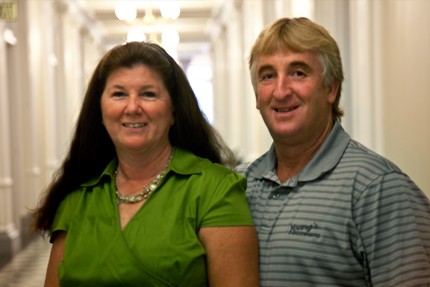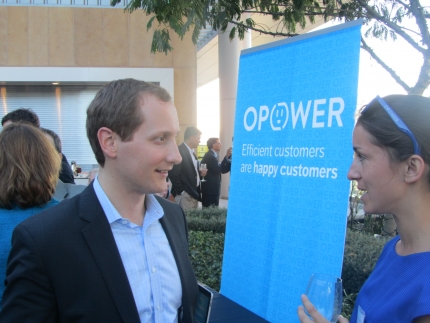Champions of Change Blog
The Arts Play a Significant Role in High Academic Performance
Posted by on July 26, 2011 at 5:23 PM EDTEd. Note: Champions of Change is a weekly initiative to highlight Americans who are making an impact in their communities and helping our country rise to meet the many challenges of the 21st century.
This past week, I had the privilege of participating in what I consider a “lifetime experience” in Washington, DC. I began Tuesday, July 19, by meeting with a group of exceptional educators from across the United States who are strong advocates of integrating arts into the curriculum. Through my affiliation with the National Association of Elementary School Principals (NAESP), I have had the opportunity to meet with colleagues from other geographical areas; however, I have never been provided with an occasion to collaborate with fellow educators from other areas of the United States who share a passion for arts education. As the principal of a school in a small town in south Alabama, sitting with a superintendent from a large district in Maryland, along with directors of highly successful programs in Detroit, Chicago, Cleveland, Dallas, Oklahoma City, and the South Bronx was truly incredible. The group quickly realized that our differences in geographical locations, backgrounds, and dialect were minor. On the other hand, our common dedication toward providing schools richly immersed in the arts quickly connected us into a cohesive group.
Following our meeting with fellow educators, we were introduced to a group of actors who strongly advocate providing arts education in schools. As members of the Creative Coalition, Tim Daly (coalition president), Omar Epps, Patricia Arquette, Rachel Leigh Cook, and Minnie Driver joined our group of educators for a guided tour of the East Wing of the White House. Initial feeling of inhibitions from meeting famous individuals immediately disappeared because of their friendliness and warmth. Once given a briefing by a secret service officer, our phenomenal White House tour began. In moments, our group jelled as we took advantage of every possible photo opportunity – photos of White House memorabilia and photos with celebrities!
Learn more about EducationEmpowering Small Business
Posted by on July 26, 2011 at 4:00 PM EDT“The dairy business is getting tougher and tougher over the years,” Grant Kohler said, but he still looks forward to opening his small, family-run business, Heber Valley Artisan Cheese. Despite the tough economic conditions, Grant thinks his business, which will have a new creamery and an online operation that is rare in the dairy industry, has tremendous potential.
Heber Valley Artisan Cheese is not a typical small business. With more than 90 years of history and deep immigrant roots that spanned four generations and counting, its story epitomizes the American dream. When Albert Kohler, Grant’s grandfather, bought the Canyon View Farm in 1929, he had no idea whether his farm would survive the challenges of the Great Depression. What he did have was a tough work ethnic, an entrepreneurial spirit and the cheese making skills that he inherited from his father, who emigrated from Switzerland.
Learn more about EconomyClosing the Achievement Gap with Arts Programming
Posted by on July 26, 2011 at 12:02 PM EDTEd. Note: Champions of Change is a weekly initiative to highlight Americans who are making an impact in their communities and helping our country rise to meet the many challenges of the 21st century.
Tuesday, July 19th, 2011, was an exciting day for our school. It was an opportunity for me to participate with the White House staff and other arts education advocates in a discussion about how to continue to make arts an important part of our core curriculum. The pressure on schools to make budgetary cuts coupled with the increased stress of testing make arts programming during and after school often the first area that is cut. Sadly it disproportionately affects our neediest districts, especially those in the South Bronx. We wanted to be part of this discussion because we felt we can contribute several solutions that have worked well with our students. We believe that by transforming schools to become Arts Powered Schools, schools can become activist centers that use the arts to build a community of learners.
What is an Arts Powered School?
The Center for Arts Education, who developed the concept of Arts Powered Schools, believes as we do that all schools can be arts powered schools if they use the tools and resources of the community to help transform any school into a center of arts learning.
In New York City’s Community School District 7, we had a literacy rate of 23% in grades 3-8 in 2010. That means only about a quarter of students are reading proficiently and on or above grade-level. We believe that we need to change the culture of reading of our community by using the culture of the community as an asset to address summer learning loss. Partnering with the Multicultural Music Group, Yale Black Alumni Association, local teaching artists, teachers and principals, we offer students two hours of music instruction and two hours of visual arts instruction to inspire students to attend academic instruction that focuses on building reading stamina and a love for reading. This initiative is a three week summer program we call the "Summer Bridge Arts Institute." This program engages students in reading while developing students’ acumen through culturally relevant art. By developing great artists we know we can make great readers!
Energy Information Helps Save Money and the Planet
Posted by on July 26, 2011 at 11:27 AM EDTWhile the U.S. is known around the world for innovative companies like Google and Facebook, there is a new vanguard of American companies creating and exporting clean energy technologies,” said Jim Kapsis. His company, OPower, an information-enabled energy efficiency company, is one of them. Opower is transforming the relationship between consumers and how they use energy in their homes. According to Kapsis, Opower is on track to save households more than $100 million next year and enough energy to take the equivalent of more than 100,000 households off the grid.
Founded in 2007 by two college buddies, the company started out with a simple idea: utility bills are too difficult to understand. The friends, co-founders, Dan Yates and Alex Laskey, bet that if people had better information about their energy usage, they would use less of it, save money, and improve the environment. “It was an innovative business idea, but given the complexity of the energy market, they weren’t sure at first that it was going to work,” said Kapsis. By working with utility companies to deliver better information to their customers, OPower not only helps people understand how they are consuming energy, but how they are doing relative to other similar homes in their neighborhood. By coupling this context with personalized energy saving advice, Opower is giving households the tools to make more informed choices about their energy use.
Learn more about Economy, Energy and EnvironmentThe Arts as Champions of Change in Our Schools
Posted by on July 25, 2011 at 7:26 PM EDTEd. Note: Champions of Change is a weekly initiative to highlight Americans who are making an impact in their communities and helping our country rise to meet the many challenges of the 21st century.
I am honored to be a White House Champion of Change – I am both humbled and inspired by my fellow Arts Education Champions, who are all working with passion and persistence to improve the lives of children everyday across our country. I applaud President Obama for taking a leadership role in acknowledging the power of the arts to transform communities, to improve education and to drive our economy. I truly appreciated the opportunity to participate in a lively exchange of ideas with members of the President’s Committee on the Arts and the Humanities and The Creative Coalition, and staff from the US Department of Education, the Arts Education Partnership, and Americans for the Arts during our recent round-table discussion.
My work at CAPE – Chicago Arts Partnerships in Education – is rooted in the belief that the arts can play a leading role in transforming education, particularly for students who have been left behind by traditional schools. In fulfilling our organization’s mission to increase student success through arts driven education, we have inspired change in different ways:
Learn more about EducationComing Together to Rebuild
Posted by on July 22, 2011 at 4:03 PM EDTEd. Note: Champions of Change is a weekly initiative to highlight Americans who are making an impact in their communities and helping our country rise to meet the many challenges of the 21st century.

Glen and I had a wonderful time in Washington DC on July 6th. Everyone was courteous and made us feel comfortable and at ease. We were also thrilled that we got to meet President Obama and talk with him. Secretary Vilsack also impressed us with his knowledge of agricultural rules. All in all it was exciting to know that the Department of Agriculture wanted our input. We felt honored to be invited to the White House.
We have always said that hard work pays off. We have been a family-run business for over thirty years, with four generations at our greenhouse: Elma (first owners), Glen (Elma’s son), Benjamin (Glen’s son), and Carson (Ben’s five year old son). It started with our mother and father, Earl and Elma Young, growing and selling vegetables. Then we began to sell flowers. The first time we ever bought hanging baskets to sell, we bought eight fuchsias. We thought we had bought too many hangers and were going to get stuck with them. Now, after thirty years, we sell four hundred fuchsia hangers and over twenty thousand other hangers. Our greenhouses cover a total of two acres.
In the fall of 2009, a tornado came and tore through our greenhouses, leaving only four standing. The four left standing had to be torn down because the tornado shifted the bars and they were not safe. We were all on vacation the day the tornado came through. When we came back, we took a deep breath and knew we had to rebuild, and that we had to rebuild before the ground froze, because metal poles had to be put into the ground for the frames.
Learn more about Rural
- &lsaquo previous
- …
- 167
- 168
- 169
- 170
- 171
- 172
- 173
- 174
- 175
- …
- next &rsaquo
White House Blogs
- The White House Blog
- Middle Class Task Force
- Council of Economic Advisers
- Council on Environmental Quality
- Council on Women and Girls
- Office of Intergovernmental Affairs
- Office of Management and Budget
- Office of Public Engagement
- Office of Science & Tech Policy
- Office of Urban Affairs
- Open Government
- Faith and Neighborhood Partnerships
- Social Innovation and Civic Participation
- US Trade Representative
- Office National Drug Control Policy
categories
- AIDS Policy
- Alaska
- Blueprint for an America Built to Last
- Budget
- Civil Rights
- Defense
- Disabilities
- Economy
- Education
- Energy and Environment
- Equal Pay
- Ethics
- Faith Based
- Fiscal Responsibility
- Foreign Policy
- Grab Bag
- Health Care
- Homeland Security
- Immigration
- Innovation Fellows
- Inside the White House
- Middle Class Security
- Open Government
- Poverty
- Rural
- Seniors and Social Security
- Service
- Social Innovation
- State of the Union
- Taxes
- Technology
- Urban Policy
- Veterans
- Violence Prevention
- White House Internships
- Women
- Working Families
- Additional Issues



